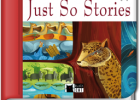Just So Stories
0. Rudyard Kipling
P. Project on the web (I)
1.1. The Elephant’s Child (part one)
1.2. The Elephant’s Child (part two)
2. Old Man Kangaroo
D. The Animals of Australia
P. Project on the web (II)
3.1. How the Leopard Got His Spots (part one)
3.2. How the Leopard Got His Spots (part two)
4. How the Whale Got His Throat
D. Whales
P. Project on the web (III)
5. How the Camel Got His Hump
A. After Reading
Este libro contiene:
-
14 secuencias
-
65 recursos
-
Idioma:
- Inglés
Libro de texto
-
1. Rudyard Kipling
- Ir a ficha de secuencia
- 0 secuencias
- 2 recursos
Name: Joseph Rudyard Kipling. Born: 30 December 1865 in Bombay (now called Mumbai), India. Most famous book: The Jungle Book (1894). Other books: The Second Jungle Book (1895), Captains Courageous (1897), Kim (1901), Just So Stories (1902). Travels: England, United States, India, South Africa.
-
2. Project on the web (I)
- Ir a ficha de secuencia
- 0 secuencias
- 2 recursos
Connect to the Internet and go to www.blackcat.vicensvives.net. Insert the title or part of the title of the book into our search engine (buscador). Click on Just So Stories. Clik on Project links, and then on the relevant link for this project.
-
3. The Elephant’s Child (part one)
- Ir a ficha de secuencia
- 0 secuencias
- 8 recursos
The Elephant’s Child (part one)
-
4. The Elephant’s Child (part two)
- Ir a ficha de secuencia
- 0 secuencias
- 4 recursos
The Elephant’s Child arrives at the Limpopo River. He sees a new animal in the big green river. ‘What a strange animal,’ he thinks. ‘What is it?’ ‘Excuse me,’ he asks, ‘does a Crocodile live here?’ ‘Yes, Little Elephant,’ says the new animal in the green river. ‘I’m a Crocodile.’ ‘Oh, good!’ says the Elephant’s Child. ‘Can you please tell me what you have for dinner?’ ‘Yes, of course,’ says the Crocodile, happily. [...]
-
5. Old Man Kangaroo
- Ir a ficha de secuencia
- 0 secuencias
- 8 recursos
Old Man Kangaroo
-
6. The Animals of Australia
- Ir a ficha de secuencia
- 0 secuencias
- 2 recursos
Australia has a lot of animals that you can’t find in other places in the world. Let’s have a look at some of them. The kangaroo The kangaroo is probably the most popular animal of Australia. The kangaroo is a marsupial – that means that is carries its young in a special pouch.1 A baby kangaroo is called a joey. When a joey is born it is very small – only about two centimetres long. [...]
-
7. Project on the web (II)
- Ir a ficha de secuencia
- 0 secuencias
- 2 recursos
Connect to the Internet and go to www.blackcat.vicensvives.net. Insert the title or part of the title of the book into our search engine (buscador). Click on Just So Stories. Clik on Project link, and then on the relevant link for this project.
-
8. How the Leopard Got His Spots (part one)
- Ir a ficha de secuencia
- 0 secuencias
- 8 recursos
-
9. How the Leopard Got His Spots (part two)
- Ir a ficha de secuencia
- 0 secuencias
- 4 recursos
‘I know the animals are here somewhere,’ says the Leopard, ‘but I can’t see them. Let’s wait until the night.’ ‘Alright,’ says the Man. They sit down and wait. When it is dark they hear and smell the Zebra and the Giraffe. The Man catches the Giraffe. ‘Now you’re mine!’ he says, happily. And the Leopard catches the Zebra. ‘And now you’re mine!’ he shouts, looking at the Zebra. ‘But there’s something strange about these animals. [...]
-
10. How the Whale Got His Throat
- Ir a ficha de secuencia
- 0 secuencias
- 9 recursos
-
11. Whales
- Ir a ficha de secuencia
- 0 secuencias
- 1 recurso
What do you know about whales? Here are some interesting facts. Whales live in the sea, but they are not fish, they are mammals.1 They need air to live. They must come up to the top of the water often to get air. They breathe2 air in and out through the blowhole on their back. When whales sleep they stay on the top of the water. The biggest whale is the blue whale. It is around 30 metres long and weighs about 200 tonnes. [...]
-
12. Project on the web (III)
- Ir a ficha de secuencia
- 0 secuencias
- 2 recursos
Connect to the Internet and go to www.blackcat.vicensvives.net. Insert the title or part of the title of the book into our search engine (buscador). Click on Just So Stories. Clik on Project link, and then on the relevant link for this project.
-
13. How the Camel Got His Hump
- Ir a ficha de secuencia
- 0 secuencias
- 8 recursos
-
14. After Reading
- Ir a ficha de secuencia
- 0 secuencias
- 5 recursos
After Reading
-
Aún no hay comentarios, ¡comparte tu opinión! Inicia sesión o Únete a Tiching para poder comentar
La licencia digital es una autorización que permite utilizar un recurso digital de acuerdo con las condiciones legales de dicho recurso. El código que recibas una vez la hayas comprado te permitirá acceder al recurso educativo digital elegido.
Puedes consultar más información en nuestra página de ayuda.






¿Dónde quieres compartirlo?
¿Quieres copiar el enlace?